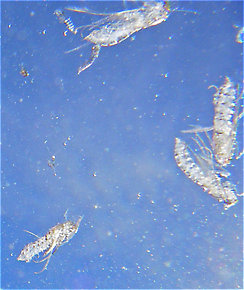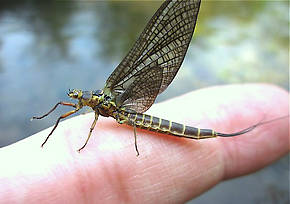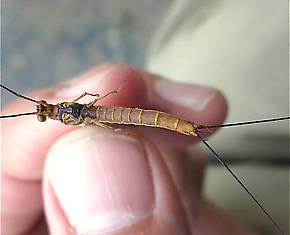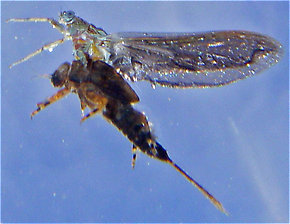Blog & Latest Updates
Fly Fishing Articles
Insects by Common Name


Mayfly Species Litobrancha recurvata (Dark Green Drake)
Taxonomic Navigation -?-
Kingdom
Animalia (Animals)
» Phylum
Arthropoda (Arthropods)
» Class
Insecta (Insects)
» Order
Ephemeroptera (Mayflies)
» Family
Ephemeridae (Hexes and Big Drakes)
» Genus
Litobrancha
» Species recurvata (Dark Green Drake)
Common Names
Where & When
Litobrancha recurvata is abundant in fewer places than other important Ephemeridae like Hexagenia limbata or Ephemera simulans, but where it does exist it has dense populations which produce good hatches. It's distribution is largely eastern, from Pennsylvania though the New England states, but it is reported for Minnesota and both Wisconsin and Michigan have good populations. They are also reported down into the mid-Atlantic states.
Emergence begins in late May in Pennsylvania. Michigan and Wisconsin follow a week or so later and peak in June. The hatch may continue through July and even into August to the north. It only lasts from three to five days on a given stretch of stream.
Hatching Behavior
These flies take a long time to escape their shucks (

Here's an underwater view of the pupal shucks of several already-emerged Brachycentrus numerosus caddisflies.
Spinner Behavior
Time Of Day: Dusk
These mayflies return as spinners one to three days after hatching. Typically the duns from more than one day will return as spinners together, creating concentrated and exciting spinner falls. Spent (Spent: The wing position of many aquatic insects when they fall on the water after mating. The wings of both sides lay flat on the water. The word may be used to describe insects with their wings in that position, as well as the position itself.) patterns can be very effective when the females fall to the surface to lay their eggs.Nymph Biology
Current Speed: Slow
Substrate: Firm silt
Environmental Tolerance: Intolerant of warm water or pollution
Caucci and Nastasi in Hatches II describe their experiments rearing these nymphs. They found that the grown nymphs, like other large burrowers, are extremely hardy, but the early nymphal stages are very sensitive to pollution or warm temperatures.Substrate: Firm silt
Environmental Tolerance: Intolerant of warm water or pollution
They take two to three years to mature before hatching.
Pictures of 3 Mayfly Specimens in the Species Litobrancha recurvata:
Female Litobrancha recurvata (Dark Green Drake) Mayfly Dun View 2 PicturesThese photos were contributed by Spencer Vanderhoof.
View 2 PicturesThese photos were contributed by Spencer Vanderhoof.
 View 2 PicturesThese photos were contributed by Spencer Vanderhoof.
View 2 PicturesThese photos were contributed by Spencer Vanderhoof.Collected May 15, 2010 from the Au Sable River (Mainstream) in Michigan
Added to Troutnut.com by Entoman on March 3, 2012
Added to Troutnut.com by Entoman on March 3, 2012
Male Litobrancha recurvata (Dark Green Drake) Mayfly Dun View 1 PicturesThese photos were contributed by Spencer Vanderhoof.
View 1 PicturesThese photos were contributed by Spencer Vanderhoof.
 View 1 PicturesThese photos were contributed by Spencer Vanderhoof.
View 1 PicturesThese photos were contributed by Spencer Vanderhoof.Collected May 15, 2010 from the Au Sable River (Mainstream) in Michigan
Added to Troutnut.com by Entoman on March 3, 2012
Added to Troutnut.com by Entoman on March 3, 2012
Male Litobrancha recurvata (Dark Green Drake) Mayfly Spinner View 1 PicturesThese photos were contributed by Spencer Vanderhoof.
View 1 PicturesThese photos were contributed by Spencer Vanderhoof.
 View 1 PicturesThese photos were contributed by Spencer Vanderhoof.
View 1 PicturesThese photos were contributed by Spencer Vanderhoof.Collected May 15, 2010 from the Au Sable River (Mainstream) in Michigan
Added to Troutnut.com by Entoman on March 3, 2012
Added to Troutnut.com by Entoman on March 3, 2012
Recent Discussions of Litobrancha recurvata
Something like recurvata, but different. 8 Replies »
Posted by DayTripper on Apr 6, 2013
Last reply on Apr 14, 2013 by Oldredbarn
Okay, I'm at a local TU meeting and a friend tells me about a double secret mystery hex hatch. According to him, these hex are colored differently than our limbata, hatch two or three weeks earlier for about 3 days only (last week of May or the first week of June), and exhibit some other "different" behavior traits. Needless to say, I was interested in learning more. Fast forward to this morning when I picked one of the nymphs up from his house after he dug a sample up for me to take home. Its still alive, so I'm trying to figure out what body parts I need photographs of to share here to see what you guys think this guy is.
A quick look at the head and tusks is pointing me to Litobrancha recurvata, and the emergence period shown in Hatches II for them is about right (May 14 to July 3). The photo they have in their color plates looks very close to what I just finished photographing, but what I have looks different.
I took a couple dozen quick photos of it and uploaded them to my flickr account, wasn't sure if it was ok or necessary to upload them all here. Link to the gallery below. Please let me know if you'd like me to upload any of these here, or if you'd like a better shot of a certain feature, so you can see the full res photo for better detail. In my non-expert opinion, I would say this nymph is near full maturity, as its ginormous. I can't find my metric ruler, but it is ~50mm long. Thanks for any help.
http://www.flickr.com/photos/cerveniak/sets/72157633180659254/
Alex
ReplyLitobrancha recurvata 4 Replies »A quick look at the head and tusks is pointing me to Litobrancha recurvata, and the emergence period shown in Hatches II for them is about right (May 14 to July 3). The photo they have in their color plates looks very close to what I just finished photographing, but what I have looks different.
I took a couple dozen quick photos of it and uploaded them to my flickr account, wasn't sure if it was ok or necessary to upload them all here. Link to the gallery below. Please let me know if you'd like me to upload any of these here, or if you'd like a better shot of a certain feature, so you can see the full res photo for better detail. In my non-expert opinion, I would say this nymph is near full maturity, as its ginormous. I can't find my metric ruler, but it is ~50mm long. Thanks for any help.
http://www.flickr.com/photos/cerveniak/sets/72157633180659254/
Alex
Posted by Crepuscular on May 14, 2012
Last reply on May 15, 2012 by Crepuscular
Collected a couple of these last week. Pretty cool mayfly if you ask me!
(User-posted images are only viewable in the forum section.)
(User-posted images are only viewable in the forum section.)
(User-posted images are only viewable in the forum section.)
(User-posted images are only viewable in the forum section.)
ReplyI agree with the nymph and emergence coments above(User-posted images are only viewable in the forum section.)
(User-posted images are only viewable in the forum section.)
(User-posted images are only viewable in the forum section.)
(User-posted images are only viewable in the forum section.)
Posted by Beardius on Aug 1, 2008
Caucci and Nastasi's comments and other comments above are correct. They are really hardy and impressive nymphs when they near maturity. Litobrancha nymphs prefer fine silty, mucky habitats in streams. They can be abundant in mucky side channels to the main stream. Their emergence occurs over a 5-day span, with the large majority emerging within a 3-day period. Therefore, large emergences are rarely encountered. When they do occur, they can be very impressive.
From my experience collecting and rearing these critters, they have a 2-year life cycle in PA and MD. They increase tremendously in size in their second year. Emergence occurred in late May into early June about a week before that of green drakes (Ephemera guttulata).
ReplyFrom my experience collecting and rearing these critters, they have a 2-year life cycle in PA and MD. They increase tremendously in size in their second year. Emergence occurred in late May into early June about a week before that of green drakes (Ephemera guttulata).
Your Thoughts On Litobrancha recurvata:
Top 10 Fly Hatches
Top Gift Shop Designs
Eat mayflies.
Top Insect Specimens
Miscellaneous Sites
Troutnut.com is copyright © 2004-2024 Jason
Neuswanger (email Jason). See my FAQ for information about use of my images.
 privacy policy
privacy policy

